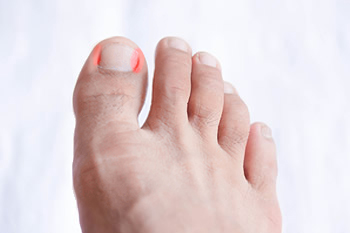Call Us Today! (203) 975-9600
SAME DAY APPOINTMENTS AVAILABLE
Managing an Ingrown Toenail
Tuesday, 13 May 2025 00:00
An ingrown toenail occurs when the side or corner of the nail grows into the surrounding skin, often resulting in pain, redness, and swelling. This condition most commonly affects the big toe and can worsen if left untreated. A podiatrist can diagnose an ingrown toenail by examining the affected area and evaluating any signs of infection, such as pus, warmth, or foul odor. If an infection is present, antibiotics may be prescribed. In moderate to severe cases, a podiatrist may recommend surgery to remove a portion of the nail, a procedure known as a partial nail avulsion. Additional options like splinting or bracing may be used to help the nail grow in the correct direction. People with diabetes or poor circulation are at a higher risk for complications and should seek prompt medical care. If you have an ingrown toenail that is causing pain, it is suggested that you schedule an appointment with a podiatrist for appropriate treatment.
Ingrown toenails can become painful if they are not treated properly. For more information about ingrown toenails, contact one of our podiatrists of Preferred Footcare, LLC. Our doctors can provide the care you need to keep you pain-free and on your feet.
Ingrown Toenails
Ingrown toenails occur when a toenail grows sideways into the bed of the nail, causing pain, swelling, and possibly infection.
Causes
- Bacterial infections
- Improper nail cutting such as cutting it too short or not straight across
- Trauma to the toe, such as stubbing, which causes the nail to grow back irregularly
- Ill-fitting shoes that bunch the toes too close together
- Genetic predisposition
Prevention
Because ingrown toenails are not something found outside of shoe-wearing cultures, going barefoot as often as possible will decrease the likeliness of developing ingrown toenails. Wearing proper fitting shoes and using proper cutting techniques will also help decrease your risk of developing ingrown toenails.
Treatment
Ingrown toenails are a very treatable foot condition. In minor cases, soaking the affected area in salt or antibacterial soaps will not only help with the ingrown nail itself, but also help prevent any infections from occurring. In more severe cases, surgery is an option. In either case, speaking to your podiatrist about this condition will help you get a better understanding of specific treatment options that are right for you.
If you have any questions please feel free to contact our office located in Stamford, CT . We offer the newest diagnostic and treatment technologies for all your foot and ankle needs.
Call Us Today! (203) 975-9600
SAME DAY APPOINTMENTS AVAILABLE








